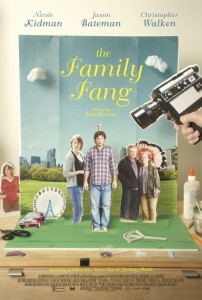
A child walks into a bank and slips the teller a note. The note reads “Stay calm and give me all of your lollipops.” The bank teller smirks and passes the child a lollipop. Stone-faced, the child brandishes a gun, erasing the smirk from the teller’s face. As she unloads the jar of lollipops for the child, a security guard intervenes, tackling the child. In the process, a bystander is shot and her daughter cries out in fear. The guard and the boy bandit rush to the woman’s aide, with the boy licking up the blood. He laughs and states it tastes like maple syrup, prompting the guard, the daughter, and the bystander to burst out laughing. The four gather themselves and walk out of the bank together. Everyone in the bank stands around dumbfounded; they were the victims of a prank.
The titular Family Fang are performance artists that have become an indie sensation. Some see their stunts as brilliant social commentary on life, while others see it as nothing more than hollow gags. Regardless, the family has amassed great success, at least for performance artists. What they haven’t achieved is a healthy lifestyle, with the children growing up emotionally crippled.
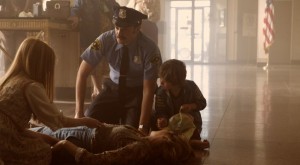
It’s present day and the children, Annie (Nicole Kidman) and Baxter (Jason Bateman), are walking emotional train wrecks. Both have tried to move past their performance art and carve out their own talent, with Annie becoming an actress and Baxter a writer. Annie lives in the shadow of her past, with most not taking her seriously as an actress. She protests a topless scene in one of her films, only to cave in and do so under her control: she struts onto set topless, making the art about her. As for Baxter, he’s suffering from writer’s block brought on by the negative reception of his second novel.
A freak accident involving Baxter being shot in the head with a potato (you read that right) brings the siblings together, reuniting them with their eccentric parents, Caleb (Christopher Walken) and Camille (Maryann Plunkett). Tension flares up immediately as the parents try to recruit their children to partake in a prank for old time’s sake, which the two deny. After the stunt fails, the parents blame their children and embark on a personal retreat. A day after they leave, the police arrive to inform the children Fang that their parents have disappeared and are presumed dead.
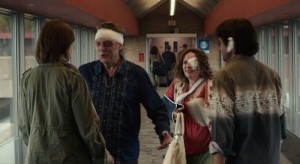
With their entire lives being surrounded by performance art stunts, the two don’t quite buy that their parents are indeed missing. Annie more so, who feels the two are being punished for rejecting their parents and trying to move on with their lives. A fight before their disappearance shows Caleb as disappointed in his children for what he deems popcorn entertainment, not art. Baxter is more willing to belief his parents are actually gone, especially when presented with evidence that these abductions have been recurring for nearly a year. The two embark on a quest to uncover the truth and find out if their parents are actually dead or are pulling off their biggest stunt yet.
“The Family Fang” is based on a novel by Kevin Wilson, which I haven’t read but I suspect is a good read. The story is tantalizing enough to make for an enriching read. It doesn’t translate well to screen, with David Lindsay-Abaire’s screenplay being too on the nose. Everything is spelled out for the audience, with the characters constantly professing their emotional problems to the world. This doesn’t come across as natural, but forced upon the characters in order to fully explain to the audience what the purpose is. It shows a severe lack of confidence in both the material and the intelligence of the viewer.
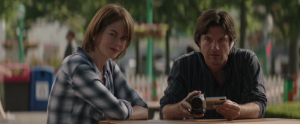
One device used to spell things out for the audience is documentary footage spliced into the film. It shows two critics debating on the artistic merit of the Family Fang, helpfully telling the audience how to interpret the art. It also shows interviews with the parents who bluntly explain their lackluster parenting skills, just to ensure to the audience that it was their (arguably unintentional) neglect that damaged their children. Caleb even states point blank that he hated the idea of having children, fearing they would ruin his art. In his eyes, his life was over, that is until he discovered he could incorporate them into his art. It’s a surprise he didn’t look into the camera and say “I’m the reason my children are messed up!”
Thankfully he didn’t, as there is some restraint in the direction. This is Jason Bateman’s second directorial effort, after the underwhelming “Bad Words,” and he’s showing improvement. He still lacks the confidence needed to reign in the proceedings and let the story speak for itself, but he was dealt a bad hand this time around. What he does do well is in handling himself and his fellow actors, pulling tremendous performances out of everyone! One almost forgives the script’s shortcomings due to the strength of the performances which humanize the overly written characters.
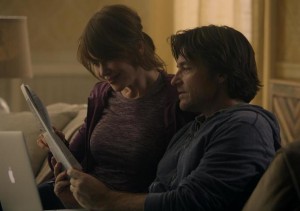
There’s a good film hiding in “The Family Fang,” one that I desperately wanted to see reveal itself. It does in the form of the performances, and the reveal at the end is rather ingenious. It doesn’t feel earned, though, making one wish it were. I wanted to like “The Family Fang,” warts and all, but anytime I grew comfortable with it, the overwritten script reared its ugly head. One of the criticisms lodged against the performance artists in the documentary was that their stunts were hollow; fitting as that’s how the overall production felt.
Final Rating: C+
